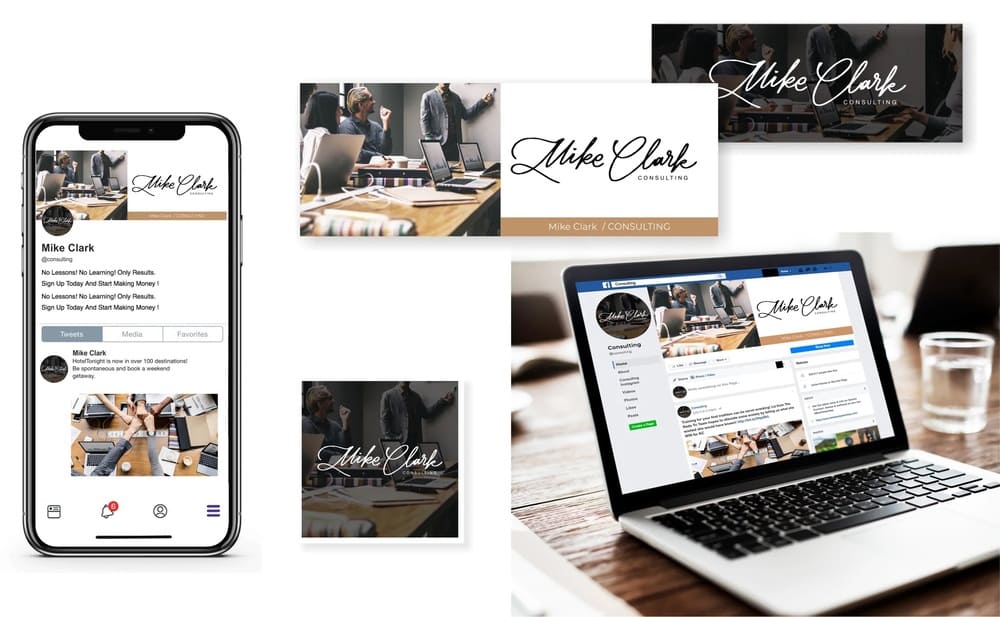In the business world of today, where competition is high, it's important to have a strong brand personality. A brand identity is more than just a logo or a catchy tagline. It encompasses the overall image, values, and personality of your business. In this piece, we'll talk about how important it is to have a unique brand identity and give you tips on how to make one that speaks to your target audience. This guide will help you find your way through the exciting world of brand identity, whether you are a new business owner or a long-time business owner who wants to improve your brand.

What Is Brand Identity?
The visual and verbal branding components that set your company apart from competitors in the market are referred to as brand identity. It includes your company name, logo, color palette, typography, imagery, content and messaging. Your target audience will understand your business's beliefs, character, and mission through its well-rounded depiction.
Why Is Brand Identity Important?
Differentiation
Having a distinctive brand identification makes you stand out from the competitors in a congested market. It makes it simpler for customers to choose you over rivals by enabling them to recognize and recall your company.
Trust and Credibility
Establishing a robust and coherent brand identity fosters credibility and trust among your target audience. A well-defined and consistent brand communicates professionalism and dependability, which increases the likelihood that buyers will select your goods or services.
Emotional Connection
A strong brand identity stimulates feelings and establishes a stronger connection with your target market. It develops a feeling of community and loyalty, which results in enduring relationships with customers.
Increased Brand Awareness
Building recognition and familiarity with your target audience is facilitated by a well-crafted and consistent brand identity. When customers see your logo, colors, and other brand elements consistently across different platforms, they begin to associate them with your business. Customer loyalty and trust are fueled by this recognition, increasing the likelihood that they will select your goods or services over rivals.

How To Create a Brand Identity
Define Your Brand Strategy
Establish your brand strategy first and foremost. Determine your distinct selling point, target market, and brand positioning. Recognize what distinguishes your organization from the competition and what benefits you deliver to customers.
Conduct Market Research
Conduct extensive market research to learn more about your industry, target audience, and rivals. Determine current market trends, customer preferences, and market gaps that your brand can address. This research will assist you in making informed judgments as you establish your brand identity.
Develop Your Brand Persona
Determine the personality and tone of your brand. Consider attributes such as friendly, professional, innovative, or trustworthy. This will guide the visual and verbal elements of your brand identity, ensuring consistency in your messaging.
Design Your Logo
Design an exclusive and unforgettable logo that embodies your brand's principles and connects deeply with the audience you aim to reach. Hire a professional designer or use online logo makers to create a visually appealing and versatile logo that can be used across different platforms.
Choose Your Color Palette
Choose a color palette that expresses the personality of your business and appeals to your target audience. Colors evoke emotions and can influence how your brand is perceived. Choose colors that align with your brand's values and are visually pleasing.
Create Consistent Visual Elements
Create recognizable visual components that complement the tone and message of your brand, such as fonts, images, and graphics. These elements should be used consistently across all marketing materials, website design, packaging, and any other touchpoints where your brand is represented.
Write a Brand Story
Develop a captivating narrative about your brand that effectively conveys its values, mission, and historical journey. This narrative should strike a chord with your intended audience, fostering an emotional bond with your brand. Incorporate this story into your marketing collateral, website, and social media to enthrall customers and set your brand apart.
Develop Brand Guidelines
Make a set of brand rules outlining how your company should be portrayed visually and verbally. These standards should cover logo usage, color palette, typography, tone of voice, and any other visual or verbal characteristics that are important to your brand identity. These rules will guarantee that all brand communications are consistent and coherent.
Implement and Monitor
Once you have developed your brand identity, it's important to implement it consistently across all touchpoints. Everything from your website and social media to your packaging and advertising falls under this category. To determine the success of your brand's identity, gather feedback from customers, analyze data, and conduct market research. Make changes as needed to strengthen and improve the effect of your brand.

What Elements Make Up a Brand Identity?
Logo
Your brand is visually represented through your logo. It need to be distinctive, uncomplicated, and evocative of your brand's essence. A well-designed logo may increase brand awareness and immediately communicate your company's values to potential clients.
Color Palette
Colors have a strong influence on our emotions and perceptions. Choose a color palette that aligns with your brand personality and evokes the desired emotions in your target audience. Consistency in using these colors across all brand touchpoints is crucial for brand recognition and cohesiveness.
Typography
The personality and style of your brand may be shown in many ways through the fonts you use. Opt for fonts that are legible and reflect your brand values. Consistency in typography across all communication channels helps reinforce your brand identity.
Brand Image
Your website, social media accounts, and marketing materials all heavily rely on the photos you employ to convey your brand. Whether it's original photography, illustrations, or stock images, ensure they align with your brand's aesthetics and values.
Brand Voice
Your brand's tone of voice refers to the style and manner in which you communicate with your audience. It should be consistent across all written and verbal communication, whether it's on your website, social media, or in your advertising campaigns. Your tone of voice should align with your brand's values and personality, whether that's professional, friendly, humorous, or authoritative.
How Can a Brand Identity Help To Create Customer Trust?
Building brand loyalty and customer trust requires a strong brand identity. Customers can tell a company is trustworthy and credible when it has a clear and consistent brand identity. A sense of familiarity and dependability is aided by the brand's consistency in visual components like logos, colors, and typography as well as in its tone of voice. It can also develop a strong bond with consumers by producing a unified and unforgettable brand experience.
Customers are more inclined to stick with a brand and make repeat purchases when they have a deep emotional connection to it. They have faith that the company would constantly keep its word and give them a satisfying experience. This loyalty and trust can then result in a rise in client retention, word-of-mouth recommendations, and eventually steady business growth.
How Is An Email Signature Related To Brand Identity
Email signatures are an often overlooked but important aspect of brand identity. They are the concluding message to your emails and can have a huge impact on how recipients perceive your brand. Here are a few reasons why email signatures are crucial for maintaining a consistent and professional brand identity:
Brand Recognition
Including your brand logo and colors in your email signature helps to reinforce your brand identity. When recipients see your logo and colors consistently in your emails, it creates a sense of familiarity and reinforces your brand's visual identity. Making your brand more memorable and recognizable can be achieved by doing this.
Professionalism
A well-designed email signature gives a professional touch to your incoming emails. It indicates that you are attentive to even the smallest details and take your brand and business seriously. By demonstrating professionalism, you can gain the confidence and credibility of your recipients, which will raise the possibility that they will regard your business as reliable and respectable.
Consistency
Just like with other brand touchpoints, consistency is key when it comes to email signatures. Using the same fonts, colors, and overall design as your other brand materials helps to create a cohesive and unified brand identity. This consistency across all communication channels reinforces your brand and helps to build a strong and recognizable brand presence.
Contact Information
A simple and practical way to provide recipients access to your contact details is through email signatures. This can contain links to your social network accounts, your name, title, phone number, and the name of your organization. By adding this information to your email signature, you facilitate communication and brand engagement for recipients. Through being approachable and open, you can foster dialogue and trust, which will ultimately assist to establish your brand identity.
Personalization
Email signatures offer an opportunity to personalize your communication and make it more human. Including a personalized message or quote in your email signature can add a personal touch and help to create a connection with your recipients. Your brand's identity can be strengthened by this personalization, which can increase brand recall and relatability.
Marketing Opportunities
Email signatures can also be utilized for marketing purposes. By including a call-to-action or a link to your latest promotion or content in your email signature, you can drive traffic to your website or social media platforms. This can help to generate leads and increase brand exposure, further solidifying your brand identity.
Why Is a Company's Brand Name An Integral Part Of Its Brand Identity?
Because it is the principal identifier of the organization, the brand name is an essential component of its brand identity. It is the name that customers and potential customers identify with the company's products or services. A brand name is the essence, the heart and soul of brand equity.
A powerful and recognizable brand name will stick in the minds of customers and help the business differentiate itself from rivals. When examining a given sector or territory, it is typically the first thing that springs to mind. The organization's reputation is shaped in large part by its brand name.
A well-chosen and well-positioned brand name can elicit specific emotions, values, and attributes in the target audience. It may succinctly and successfully convey the mission, vision, and USPs of the business. In addition, the brand name can be found on websites, social media platforms, advertisements, marketing materials, and other locations. Using the brand name consistently helps to build consumer identification and loyalty as well as brand identity.
Conclusion
In conclusion, creating a strong brand identity is essential in today's competitive business landscape. It involves defining your brand strategy, conducting market research, and developing consistent visual and verbal elements. A well-crafted brand identity differentiates your business, builds trust and credibility, fosters emotional connections, and increases brand awareness.
Key elements of a brand identity include the logo, color palette, typography, brand image, and brand voice. Email signatures also play a crucial role in maintaining a consistent and professional brand identity by reinforcing brand recognition and professionalism. Finally, a company's brand name is integral to its brand identity as it serves as the primary identifier, shapes perception, and is used across various touchpoints to build recognition and loyalty.
Final Thoughts
Immerse yourself in the world of personalized artistry with Artlogo. We excel in crafting elegant handwritten signature ideas, signature logos, watermarks, and beyond - we even have our own free signature maker. Whether you're a small-scale entrepreneur, independent professional, or a vital part of a major enterprise, imprint a lasting memory wherever you venture with Artlogo.


























Share to: